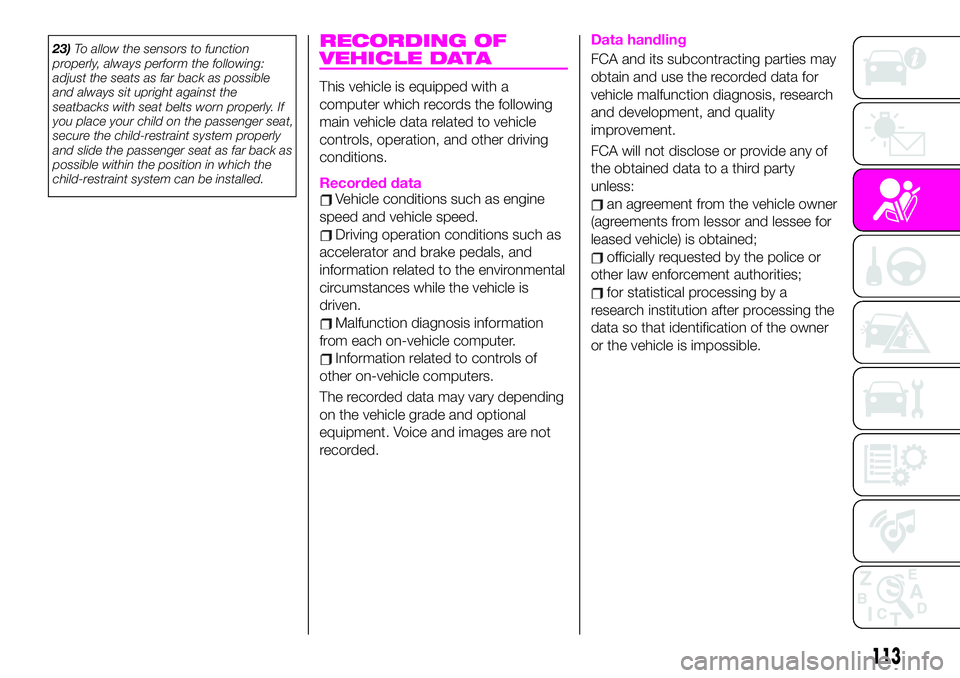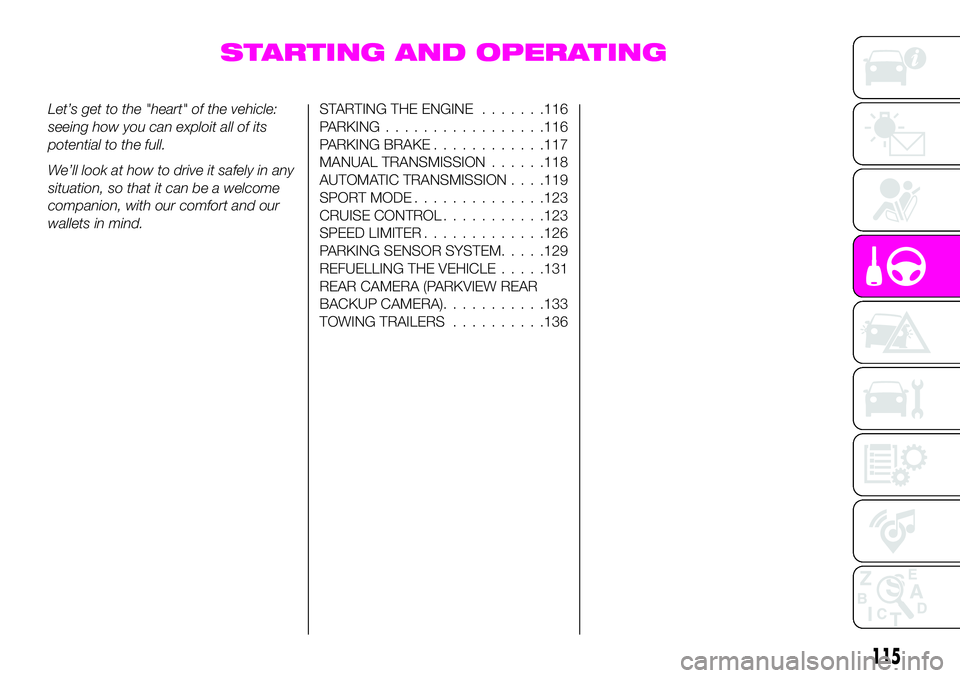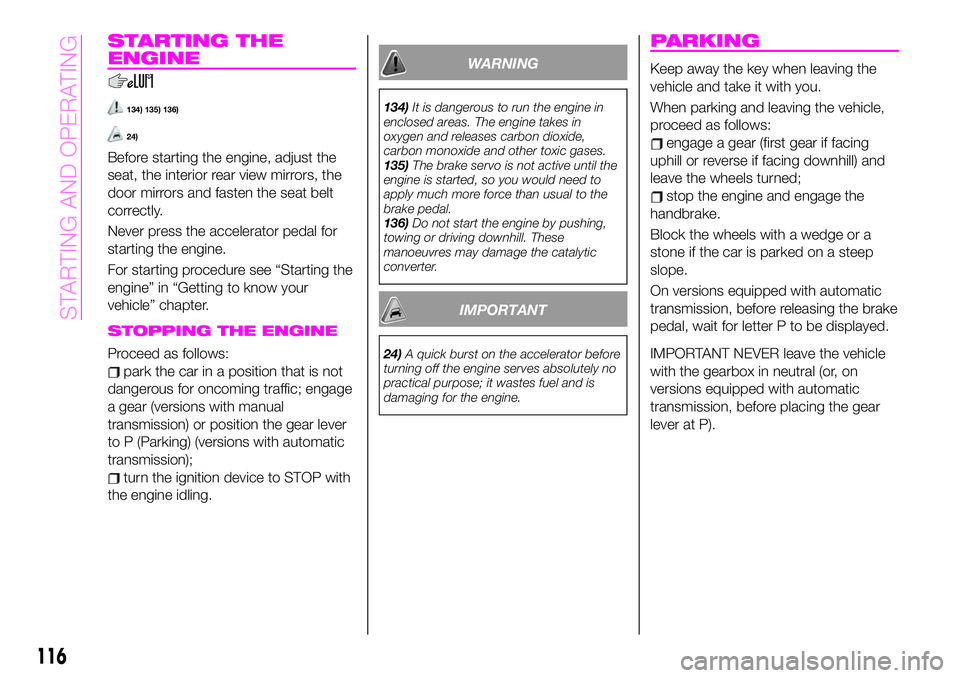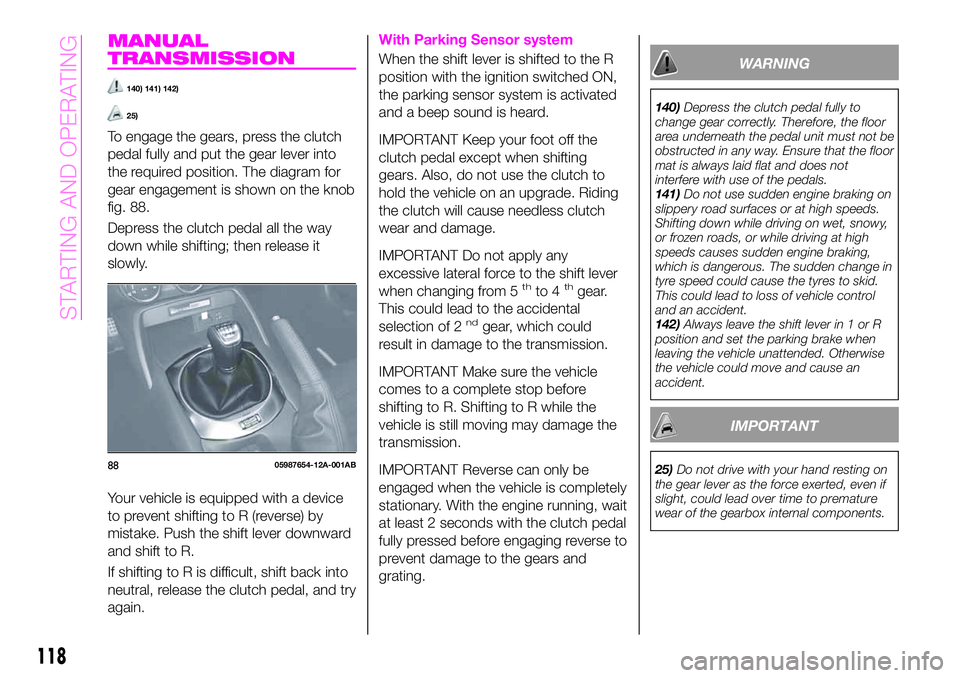Abarth 124 Spider 2020 Owner handbook (in English)
Manufacturer: ABARTH, Model Year: 2020, Model line: 124 Spider, Model: Abarth 124 Spider 2020Pages: 224, PDF Size: 3.9 MB
Page 111 of 224

Passenger air bag deactivation indicator light on/off condition chart
If the passenger occupant classification sensor is normal, the indicator light turns on when the ignition is switched ON. The light
turns off after a few seconds. Then, the indicator light turns on or is off under the following conditions:
Condition detected by the
passenger occupant
classification systemPassenger air bag
deactivation indicator lightPassenger front and side air
bagsPassenger seat belt
pretensioner system
Empty (Not occupied)Deactivated Deactivated
A child is seated in a
child-restraint system (*)
Deactivated Deactivated
Adult (**)
(***)Ready Ready
(*) The occupant classification sensor may not detect a child seated on the seat, in a child-restraint system, or a junior seat
depending on the child's physical size and seated posture.
(**) If a smaller adult sits on the passenger seat, the sensors might detect the person as being a child depending on the
person's physique.
(***) Turns off after a short period of time.
If both of the passenger air bag deactivation indicator lights do not turn on for a specified period of time when the ignition is
switched ON or they do not turn on as indicated in the passenger air bag deactivation indicator light on/off condition chart, do
not allow an occupant to sit in the passenger seat and contact an Abarth Dealership as soon as possible. The system may not
work properly in an accident.
109
Page 112 of 224

WARNING
116)Seat belts must be worn in air bag
equipped vehicles. Depending only on the
air bags for protection during an accident
is dangerous. Alone, air bags may not
prevent serious injuries. The appropriate air
bags can be expected to inflate only in the
first accident, such as frontal, near frontal
or side collisions that are at least
moderate. Vehicle occupants should
always wear seat belts.
117)Always make sure the passenger air
bag deactivation OFF indicator light is
illuminated when using a child-restraint
system. Seating a child in a child-restraint
system that is installed on the passenger
seat with the passenger air bag
deactivation OFF indicator light not
illuminated is extremely dangerous. In an
accident, an air bag could inflate and
cause serious injuries or even death to the
child seated in the child-restraint system.
Always make sure the passenger air bag
deactivation OFF indicator light is
illuminated.118)EXTREME HAZARD! Never use a
rear-facing child-restraint system on the
passenger seat with an air bag that could
deploy. NEVER use a rearward facing
child-restraint on a seat protected by an
ACTIVE AIR BAG in front of it, DEATH or
SERIOUS INJURY to the CHILD can occur.
Even in a moderate collision, the
child-restraint system can be hit by a
deploying air bag and moved violently
backward resulting in serious injury or
death to the child. If your vehicle is
equipped with on passenger occupant
classification system, always make sure the
passenger air bag deactivation OFF
indicator light is illuminated.
119)Do not sit too close to the driver and
passenger air bags. Sitting too close to the
driver and passenger air bag modules or
placing hands or feet on them is extremely
dangerous. The driver and passenger air
bags inflate with great force and speed.
Serious injuries could occur if someone is
too close. The driver should always hold
onto only the rim of the steering wheel. The
passenger should keep both feet on the
floor. Seat occupants should adjust their
seats as far back as possible and always
sit upright against the seat backs with seat
belts worn properly.120)Do not sit too close to a door or lean
against doors in vehicles with side air bags.
Sitting too close to the side air bag
modules or placing hands on them is
extremely dangerous. A side air bag
inflates with great force and speed directly
out of the outer shoulder of the seat and
expands along the door on the side the car
is hit. Serious injury could occur if someone
is sitting too close to the door or leaning
against a window in the seats.
Furthermore, sleeping up against the door
or hanging out the driver-side window while
driving could block the side air bag and
eliminate the advantages of supplementary
protection. Give the side air bags room to
work by sitting in the center of the seat
while the vehicle is moving with seat belts
worn properly.
121)Sit in the center of the seat and wear
seat belts properly. Sitting too close to the
side air bag modules or placing hands on
them, or sleeping up against the door or
hanging out the windows is extremely
dangerous. The side air bags inflate with
great force and speed directly expanding
along the door on the side the car is hit.
Serious injury could occur if someone is
sitting too close to the door. Give the side
air bags room to work by sitting in the
center of the seat while the vehicle is
moving with seat belts worn properly.
122)Do not attach objects on or around
the area where driver and passenger air
bags deploy. Attaching an object to the
driver and passenger air bag modules or
placing something in front of them is
dangerous. In an accident, an object could
interfere with air bag inflation and injure the
occupants.
110
SAFETY
Page 113 of 224

123)Do not attach objects on or around
the area where a side air bag deploys.
Attaching objects to the seat in such a way
as to cover the outboard side of the seat in
any way is dangerous. In an accident the
object could interfere with the side air bag,
which inflates from the outboard side of the
seats, impeding the added protection of
the side air bag system or redirecting the
air bag in a way that is dangerous.
Furthermore, the bag could be cut open
releasing the gas. Do not hang net bags,
map pouches or backpacks with side
straps on the seats. Never use seat covers
on the seats. Always keep the side air bag
modules in your seats free to deploy in the
event of a side collision.
124)Do not touch the components of the
supplementary restraint system after the air
bags have inflated. Touching the
components of the supplementary restraint
system after the air bags have inflated is
dangerous. Immediately after inflation, they
are very hot. You could get burned.
125)Never install any front-end equipment
to your vehicle. Installation of front-end
equipment, such as frontal protection bar
(kangaroo bar, bull bar, push bar, or other
similar devices), snowplow, or winches, is
dangerous. The air bag crash sensor
system could be affected. This could cause
air bags to inflate unexpectedly, or it could
prevent the air bags from inflating during an
accident. Occupants could be seriously
injured.126)Do not modify the suspension.
Modifying the vehicle suspension is
dangerous. If the vehicle's height or the
suspension is modified, the vehicle will be
unable to accurately detect a collision
resulting in incorrect or unexpected air bag
deployment and the possibility of serious
injuries.
127)Do not modify a door or leave any
damage unrepaired. Always have an expert
repairer, we recommend an Abarth
Dealership inspect a damaged door.
Modifying a door or leaving any damage
unrepaired is dangerous. Each door has a
side crash sensor as a component of the
supplementary restraint system. If holes
are drilled in a door, a door speaker is left
removed, or a damaged door is left
unrepaired, the sensor could be adversely
affected causing it to not detect the
pressure of an impact correctly during a
side collision. If a sensor does not detect a
side impact correctly, the side air bags and
the seat belt pretensioner may not operate
normally which could result in serious injury
to occupants.128)Do not modify the supplementary
restraint system. Modifying the
components or wiring of the
supplementary restraint system is
dangerous. You could accidentally activate
it or make it inoperable. Do not make any
modifications to the supplementary
restraint system. This includes installing
trim, badges, or anything else over the air
bag modules. It also includes installing
extra electrical equipment on or near
system components or wiring. An expert
repairer, we recommend an Abarth
Dealership can provide the special care
needed in the removal and installation of
seats. It is important to protect the air bag
wiring and connections to assure that the
bags do not accidentally deploy, and that
the passenger occupant classification
system and the seats retain an undamaged
air bag connection.
129)Do not place luggage or other objects
under the seats. Placing luggage or other
objects under the seats is dangerous. The
components essential to the
supplementary restraint system could be
damaged, and in the event of a side
collision, the appropriate air bags may not
deploy, which could result in death or
serious injury. To prevent damage to the
components essential to the
supplementary restraint system, do not
place luggage or other objects under the
seats.
111
Page 114 of 224

130)Do not operate a vehicle with
damaged air bag/seat belt pretensioner
system components. Expended or
damaged air bag/seat belt pretensioner
system components must be replaced
after any collision which caused them to
deploy or damage them. Only a trained
expert repairer, we recommend an Abarth
Dealership that can fully evaluate these
systems to see that they will work in any
subsequent accident. Driving with an
expended or damaged air bag or
pretensioner unit will not afford you the
necessary protection in the event of any
subsequent accident which could result in
serious injury or death.
131)Do not remove interior air bag parts.
Removing any components such as the
seats, front instrument panel, the steering
wheel, containing air bag parts or sensors
is dangerous. These parts contain essential
air bag components. The air bag could
accidentally activate and cause serious
injuries. Always have an Abarth Dealership
remove these parts.132)Do not allow an occupant in the
passenger's seat to sit with a posture
which makes it difficult for the passenger
occupant classification sensor to detect
the occupant correctly. Sitting in the
passenger's seat with a posture which
makes it difficult for the passenger
occupant classification sensor to detect
the occupant correctly is dangerous. If the
passenger occupant classification sensor
cannot detect the occupant sitting on the
passenger's seat correctly, the passenger
front and side air bags and pretensioner
system may not operate (non-deploy) or
they may operate (deploy) accidentally. The
passenger will not have the supplementary
protection of the air bags or the accidental
operation (deployment) of the air bags
could result in serious injury or death.133)Under the following conditions, the
passenger occupant classification sensor
cannot detect a passenger sitting on the
passenger's seat correctly and the
deployment/non-deployment of the air
bags cannot be controlled as indicated in
the passenger air bag deactivation
indicator light on/off condition chart. For
example: luggage or other items placed
under the passenger seat or between the
passenger seat and driver seat that push
up the passenger seat bottom / An object,
such as a seat cushion, is put on the
passenger's seat or between the
passenger's back and the seat back / A
seat cover is put on the passenger's seat /
Luggage or other items are placed on the
seat with the child in the child-restraint
system / The seat is washed / Liquids are
spilled on the seat / The passenger seat is
moved backward, pushing into luggage or
other items placed behind it / Luggage or
other items are placed between the
passenger seat and driver seat / An electric
device is put on the passenger's seat. The
passenger front and side air bags and seat
belt pretensioner systems will deactivate if
the passenger air bag deactivation OFF
indicator light turns on.
IMPORTANT
22)To assure proper deployment of the
front air bag and to prevent damage to the
sensor in the seat cushion: do not place
sharp objects on the seat cushion or leave
heavy luggage on them. Do not spill any
liquids on the seats or under the seats.
112
SAFETY
Page 115 of 224

23)To allow the sensors to function
properly, always perform the following:
adjust the seats as far back as possible
and always sit upright against the
seatbacks with seat belts worn properly. If
you place your child on the passenger seat,
secure the child-restraint system properly
and slide the passenger seat as far back as
possible within the position in which the
child-restraint system can be installed.RECORDING OF
VEHICLE DATA
This vehicle is equipped with a
computer which records the following
main vehicle data related to vehicle
controls, operation, and other driving
conditions.
Recorded dataVehicle conditions such as engine
speed and vehicle speed.
Driving operation conditions such as
accelerator and brake pedals, and
information related to the environmental
circumstances while the vehicle is
driven.
Malfunction diagnosis information
from each on-vehicle computer.
Information related to controls of
other on-vehicle computers.
The recorded data may vary depending
on the vehicle grade and optional
equipment. Voice and images are not
recorded.
Data handling
FCA and its subcontracting parties may
obtain and use the recorded data for
vehicle malfunction diagnosis, research
and development, and quality
improvement.
FCA will not disclose or provide any of
the obtained data to a third party
unless:
an agreement from the vehicle owner
(agreements from lessor and lessee for
leased vehicle) is obtained;
officially requested by the police or
other law enforcement authorities;
for statistical processing by a
research institution after processing the
data so that identification of the owner
or the vehicle is impossible.
113
Page 116 of 224

CONSTANT
MONITORING
The following components of the air
bag systems and the active bonnet are
monitored by a diagnostic system:
Front air bag sensors
Crash sensors, and diagnostic
module (SAS unit)
Side crash sensors
Air bag modules
Seat belt pretensioners
Air bag/Seat belt pretensioner
system warning light
Related wiring
With Passenger Occupant
Classification System
Passenger occupant classification
sensor
Passenger occupant classification
module
Passenger air bag deactivation
indicator light
With Active bonnetActive bonnet sensors
Active bonnet modules
Active bonnet warning light
The diagnostic module continuously
monitors the system's readiness. This
begins when the ignition is switched
ON and continues while the vehicle is
being driven.
114
SAFETY
Page 117 of 224

STARTING AND OPERATING
Let’s get to the "heart" of the vehicle:
seeing how you can exploit all of its
potential to the full.
We’ll look at how to drive it safely in any
situation, so that it can be a welcome
companion, with our comfort and our
wallets in mind.STARTING THE ENGINE.......116
PARKING.................116
PARKING BRAKE............117
MANUAL TRANSMISSION......118
AUTOMATIC TRANSMISSION. . . .119
SPORT MODE..............123
CRUISE CONTROL...........123
SPEED LIMITER.............126
PARKING SENSOR SYSTEM.....129
REFUELLING THE VEHICLE.....131
REAR CAMERA (PARKVIEW REAR
BACKUP CAMERA)...........133
TOWING TRAILERS..........136
115
Page 118 of 224

STARTING THE
ENGINE
134) 135) 136)
24)
Before starting the engine, adjust the
seat, the interior rear view mirrors, the
door mirrors and fasten the seat belt
correctly.
Never press the accelerator pedal for
starting the engine.
For starting procedure see “Starting the
engine” in “Getting to know your
vehicle” chapter.
STOPPING THE ENGINE
Proceed as follows:
park the car in a position that is not
dangerous for oncoming traffic; engage
a gear (versions with manual
transmission) or position the gear lever
to P (Parking) (versions with automatic
transmission);
turn the ignition device to STOP with
the engine idling.
WARNING
134)It is dangerous to run the engine in
enclosed areas. The engine takes in
oxygen and releases carbon dioxide,
carbon monoxide and other toxic gases.
135)The brake servo is not active until the
engine is started, so you would need to
apply much more force than usual to the
brake pedal.
136)Do not start the engine by pushing,
towing or driving downhill. These
manoeuvres may damage the catalytic
converter.
IMPORTANT
24)A quick burst on the accelerator before
turning off the engine serves absolutely no
practical purpose; it wastes fuel and is
damaging for the engine.
PARKING
Keep away the key when leaving the
vehicle and take it with you.
When parking and leaving the vehicle,
proceed as follows:
engage a gear (first gear if facing
uphill or reverse if facing downhill) and
leave the wheels turned;
stop the engine and engage the
handbrake.
Block the wheels with a wedge or a
stone if the car is parked on a steep
slope.
On versions equipped with automatic
transmission, before releasing the brake
pedal, wait for letter P to be displayed.
IMPORTANT NEVER leave the vehicle
with the gearbox in neutral (or, on
versions equipped with automatic
transmission, before placing the gear
lever at P).
116
STARTING AND OPERATING
Page 119 of 224

PARKING BRAKE
137) 138) 139)
IMPORTANT Driving with the parking
brake on will cause excessive wear of
the brake parts.
Setting the parking brake
Depress the brake pedal and then firmly
pull the parking brake lever fully
upwards with sufficient force to hold the
vehicle in a stationary position.
Releasing the parking brake
Depress the brake pedal and pull the
parking brake lever 1 upwards fig. 87,
then press the release button 2. While
holding the button, lower the parking
brake lever all the way down to the
released position.
Brake Assist
During emergency braking situations
when it is necessary to depress the
brake pedal with greater force, the
brake assist system provides braking
assistance, thus enhancing braking
performance.
When the brake pedal is depressed
hard or depressed more quickly, the
brakes apply more firmly.
NOTE When the brake pedal is
depressed hard or depressed more
quickly, the pedal will feel softer but the
brakes will apply more firmly. This is a
normal effect of the brake assist
operation and does not indicate a
malfunction.
NOTE When the brake pedal is
depressed hard or depressed more
quickly, a motor/pump operation noise
may be heard. This is a normal effect of
the brake assist and does not indicate a
malfunction.
NOTE The brake assist equipment does
not supersede the functionality of the
vehicle's main braking system.WARNING
137)In the case of parking manoeuvres on
roads on a gradient, the front wheels must
be steered towards the pavement (when
parking downhill), or in the opposite
direction if the vehicle is parked uphill. If the
vehicle is parked on a steep slope, it is
advisable to block the wheels with a wedge
or stone.
138)Never leave children unattended in
the vehicle. Keep away the key when
leaving the vehicle and take it with you.
139)Do not drive with worn disc pads.
Driving with worn disc pads is dangerous.
The brakes could fail and cause a serious
accident. As soon as you hear a
screeching noise contact an Abarth
Dealership.
8705050102-12A-001AB
117
Page 120 of 224

MANUAL
TRANSMISSION
140) 141) 142)
25)
To engage the gears, press the clutch
pedal fully and put the gear lever into
the required position. The diagram for
gear engagement is shown on the knob
fig. 88.
Depress the clutch pedal all the way
down while shifting; then release it
slowly.
Your vehicle is equipped with a device
to prevent shifting to R (reverse) by
mistake. Push the shift lever downward
and shift to R.
If shifting to R is difficult, shift back into
neutral, release the clutch pedal, and try
again.
With Parking Sensor system
When the shift lever is shifted to the R
position with the ignition switched ON,
the parking sensor system is activated
and a beep sound is heard.
IMPORTANT Keep your foot off the
clutch pedal except when shifting
gears. Also, do not use the clutch to
hold the vehicle on an upgrade. Riding
the clutch will cause needless clutch
wear and damage.
IMPORTANT Do not apply any
excessive lateral force to the shift lever
when changing from 5
thto 4thgear.
This could lead to the accidental
selection of 2
ndgear, which could
result in damage to the transmission.
IMPORTANT Make sure the vehicle
comes to a complete stop before
shifting to R. Shifting to R while the
vehicle is still moving may damage the
transmission.
IMPORTANT Reverse can only be
engaged when the vehicle is completely
stationary. With the engine running, wait
at least 2 seconds with the clutch pedal
fully pressed before engaging reverse to
prevent damage to the gears and
grating.
WARNING
140)Depress the clutch pedal fully to
change gear correctly. Therefore, the floor
area underneath the pedal unit must not be
obstructed in any way. Ensure that the floor
mat is always laid flat and does not
interfere with use of the pedals.
141)Do not use sudden engine braking on
slippery road surfaces or at high speeds.
Shifting down while driving on wet, snowy,
or frozen roads, or while driving at high
speeds causes sudden engine braking,
which is dangerous. The sudden change in
tyre speed could cause the tyres to skid.
This could lead to loss of vehicle control
and an accident.
142)Always leave the shift lever in 1 or R
position and set the parking brake when
leaving the vehicle unattended. Otherwise
the vehicle could move and cause an
accident.
IMPORTANT
25)Do not drive with your hand resting on
the gear lever as the force exerted, even if
slight, could lead over time to premature
wear of the gearbox internal components.8805987654-12A-001AB
118
STARTING AND OPERATING